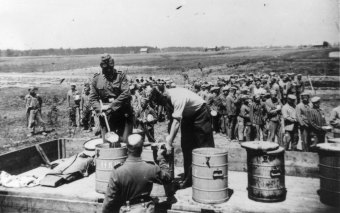Nutrition

© Fritz Bauer Institute (APMO Collection / Auschwitz-Birkenau State Museum)
In the first few weeks of the Buna/Monowitz concentration camp’s existence, food was delivered by the SS from the Auschwitz I main camp. It consisted of watery soup, the usual fare there. Starting in mid-February 1943, the Buna/Monowitz concentration camp had its own kitchen facilities, where the food for the prisoners was prepared. The kitchen work detachment operated in a separate area. There were 40 to 50 large vats, each with a capacity of 300 liters (about 80 gallons). District heat from the I.G. Farben power plant was used for cooking.
In the morning, the prisoners were given a small amount of “imitation coffee.” It was meant to be drunk with 1/5 of a loaf of bread, which was distributed the previous evening. Many inmates had already eaten it before morning. Handed out with the bread ration, according to slightly varying survivor testimonies, were 8 to 20 grams (0.3–0.7 ounces) of margarine and, once a week, 30 grams (1 ounce) of poor-quality sausage, 100 grams (3.5 ounces) of curd cheese, and 50 grams (1.8 ounces) of jam. External work detachments were given 30 grams of sausage three times a week. The prisoners received no sugar, milk, cheese, fruit, or drinking water, though the tap water in the Auschwitz area was undrinkable. Often several prisoners had to share a soup bowl. Inmates were not issued spoons; instead, they had to swap at least half a bread ration for one on the black market. Some prisoners sharpened the handles of their spoons to create makeshift knives for cutting the bread.
The principal food was soup. At midday, on the construction site, each prisoner received about .75 liter (25 ounces) of “Buna soup,” brought there in huge thermos containers from the camp kitchen at 10 o’clock, but not eaten until noon. This “Buna soup” was so called because it tasted like rubber, Buna synthetic rubber, according to Gerhard Maschkowski: “It had three colors. It might be brown, or green, or yellow. Nothing in it.”[1] It contained nettles, grass, greens, and sometimes a potato, and it had virtually no nutritional value. The main meal was served in the evening after roll call: soup again, usually made from potatoes. The big vats were brought by two vat-carriers from the kitchen to the block, where the block elder distributed the soup. Here it was advantageous to be near the end of the line, since the few vegetables sank to the bottom of the vat. The inmates who helped carry the vat had a chance to get what was left in the big pot, as additional rations.
The diet contained almost no protein, hardly any vitamins and fats, and often caused diarrhea, in the opinion of Robert Waitz, who worked as a doctor in the prisoner infirmary, because the inmates’ bodies could produce almost no gastric acid and intestinal juices.
Not only the heaviness of the work to be done, but also the opportunities to scrounge or pilfer— in the camp language, to “organize”—additional food, determined a prisoner’s chances of survival. Here the so-called VIPs had an advantage. Often the block elders kept back part of the food rations to swap for necessary articles not supplied by the SS, either for their own benefit or for the block as a whole. Pilfering occurred in the kitchen, to the enrichment of the prisoner functionaries and the SS, even though Wurziger, the I.G. Farben kitchen inspector, checked the delivery of the scant food supplies daily in the economic barracks at Monowitz, which was guarded by the SS. A job in the camp kitchen or also in the SS kitchen offered an opportunity to help out friends with extra food. At the construction site, civilian workers and Poles from the neighboring area traded surreptitiously in foodstuffs, and things stolen at the construction site, such as copper wiring, nails, or grease, were swapped for bread or soup with prisoner functionaries. Frequently, British prisoners of war also helped out by providing food and cigarettes.
Bread served as a currency substitute in the camp. Stealing a prisoner’s bread was tantamount to taking his life, and was punished by the other prisoners with death. The goal of the camp’s entire underground economy was to avoid starvation. To achieve that objective, prisoners even did extra work, including making drawings, greeting cards, or repairs, for Meister or prisoner functionaries, and at times prisoner functionaries forced younger inmates into prostitution. Anyone who could find no opportunity to get additional food soon was completely emaciated and debilitated—a so-called Muselmann in the camp language—became apathetic, and usually was quick to fall victim to a selection.
(MN; transl. KL)
















